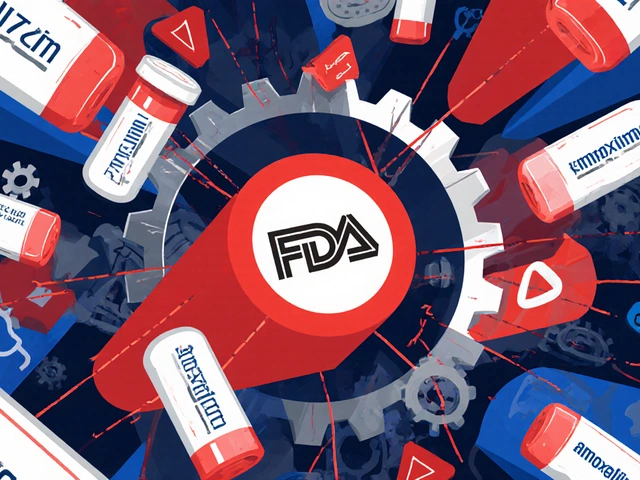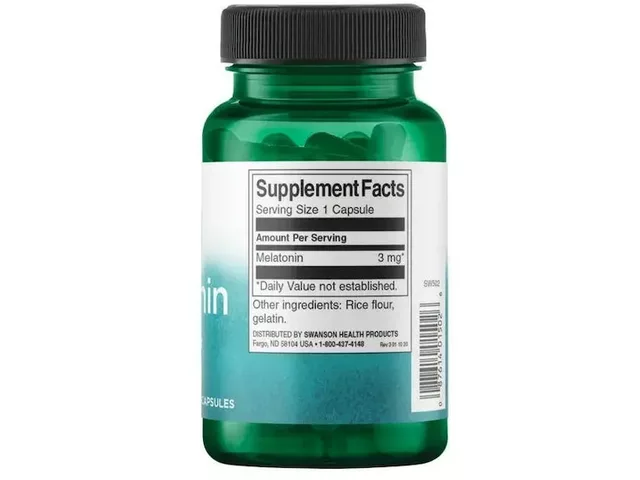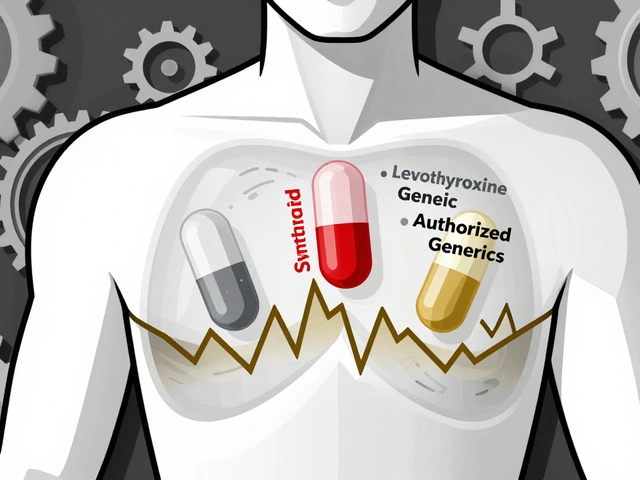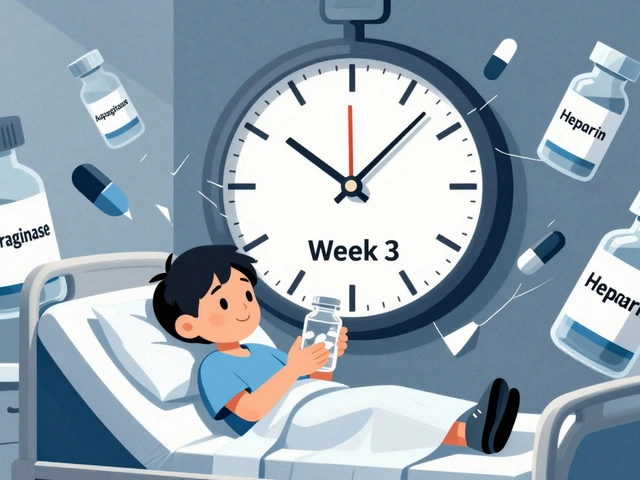
Norfloxacin vs Alternatives Decision Tool
Select Infection Type
Patient Factors
Norfloxacin is a synthetic fluoroquinolone antibiotic that works by inhibiting bacterial DNA gyrase and topoisomerase IV, stopping bacterial replication. It’s marketed in Australia under the brand name Noroxin and is supplied mainly as 400mg tablets.
Quick Snapshot
- Primary use: uncomplicated urinary tract infections (UTIs) and prostatitis.
- Typical dose: 400mg once daily for 3‑7days.
- Key side‑effects: tendon pain, QT‑interval prolongation, photosensitivity.
- Cost: moderate - roughly AUD 30‑45 for a full course.
How Norfloxacin Works
The fluoroquinolone class targets two essential bacterial enzymes. By binding to DNA gyrase, Norfloxacin prevents supercoiling of DNA, while inhibition of topoisomerase IV stops the separation of replicated chromosomes. This dual attack makes it bactericidal against many Gram‑negative organisms, especially Escherichia coli and Klebsiella pneumoniae.
When Doctors Choose Norfloxacin
In clinical practice, Norfloxacin is favored for:
- Uncomplicated lower urinary tract infections where E.coli is the presumed pathogen.
- Acute bacterial prostatitis - the drug penetrates prostatic tissue well.
- Travel‑related diarrhoea caused by Shigella or Campylobacter.
However, rising resistance and safety alerts have pushed clinicians to consider alternatives, especially for mild infections where a narrower‑spectrum drug can suffice.
Common Alternatives to Norfloxacin
Below are the most frequently prescribed substitutes, each with its own strengths and drawbacks.
Ciprofloxacin is another fluoroquinolone, broader against Gram‑negative rods but with a higher risk of tendon injury.
Levofloxacin offers once‑daily dosing and better lung penetration, making it a go‑to for respiratory infections.
Moxifloxacin is a newer fluoroquinolone with strong activity against atypical pathogens, often reserved for complex pneumonia.
Trimethoprim‑sulfamethoxazole (co‑trimoxazole) works by blocking folic‑acid synthesis; it’s cheap and effective for many UTIs but contraindicated in patients with sulfa allergy.
Nitrofurantoin concentrates in urine, making it ideal for uncomplicated cystitis; it’s safe in pregnancy but ineffective for prostatitis.
Fosfomycin is a single‑dose powder for oral suspension, convenient for patients who struggle with adherence; resistance is low but it’s not suitable for tissue‑invasive infections.

Head‑to‑Head Comparison
| Antibiotic | Spectrum (Gram‑) | Typical Indication | Dosage Form | Common Side‑effects | Approx. Cost (AUD) |
|---|---|---|---|---|---|
| Norfloxacin | Gram‑negative, limited Gram‑positive | UTI, prostatitis, traveller’s diarrhoea | 400mg tablet | Tendon pain, QT prolongation, photosensitivity | 30‑45 |
| Ciprofloxacin | Broad Gram‑negative, some Gram‑positive | UTI, intra‑abdominal, bone infection | 250‑750mg tablet | Tendon rupture, CNS effects, dysglycaemia | 20‑35 |
| Levofloxacin | Gram‑negative + atypicals | Pneumonia, sinusitis, skin infections | 500mg tablet | QT prolongation, tendon issues, insomnia | 35‑50 |
| Trimethoprim‑sulfamethoxazole | Broad, good for E.coli | UTI, MRSA skin infections | 80/400mg tablet | Rash, hyperkalaemia, renal toxicity | 10‑15 |
| Nitrofurantoin | Urine‑specific Gram‑negative | Uncomplicated cystitis | 100mg capsule | GI upset, pulmonary toxicity (long‑term) | 8‑12 |
| Fosfomycin | Broad Gram‑negative, some Gram‑positive | UTI (single‑dose) | 3g powder sachet | Diarrhoea, nausea | 25‑35 |
Decision Criteria: When to Pick Norfloxacin
Choosing the right drug isn’t about price alone. Consider these factors:
- Infection depth: For prostate involvement, Norfloxacin’s tissue penetration is a plus.
- Resistance patterns: Local antibiograms often show rising E.coli resistance to fluoro‑quinolones; if resistance >20%, go with nitrofurantoin or fosfomycin.
- Patient comorbidities: Tendon disorders, cardiac QT issues, or pregnancy steer away from Norfloxacin.
- Adherence: Single‑dose fosfomycin beats a 7‑day Norfloxacin course for busy patients.
- Cost‑insurance coverage: If a patient’s PBS schedule favours trimethoprim‑sulfa, that may win.
Practical Tips & Safety Nets
Regardless of the antibiotic, follow these safeguards:
- Ask the prescriber for a urine culture before starting therapy; it confirms the pathogen and its susceptibility.
- If you notice sudden calf or shoulder pain, stop the drug and contact a doctor - tendon injury can be irreversible.
- Avoid sun exposure while on Norfloxacin; wear sunscreen and protective clothing.
- Check for drug‑drug interactions: antacids, iron, or multivitamins can lower fluoroquinolone absorption.
- Complete the full course even if symptoms improve; partial treatment fuels resistance.
Related Concepts
Understanding Norfloxacin fits into a broader conversation about antibiotic stewardship. Topics you might explore next include:
- How to read a susceptibility report.
- Impact of over‑prescribing fluoroquinolones on public health.
- Guidelines for treating multidrug‑resistant UTIs.
Frequently Asked Questions
Can I use Norfloxacin for a simple bladder infection?
Yes, Norfloxacin is effective for uncomplicated cystitis caused by susceptible E.coli. However, many clinicians now prefer nitrofurantoin or fosfomycin because they have a lower risk of tendon injury and are cheaper.
What makes fluoroquinolones like Norfloxacin risky?
Fluoroquinolones can affect connective tissue, leading to tendonitis or even rupture. They also prolong the QT interval, which can trigger cardiac arrhythmias, especially in older adults or those on other QT‑prolonging drugs.
Is Norfloxacin safe during pregnancy?
No. The FDA classifies fluoroquinolones as Category C, and Australian guidelines advise against using Norfloxacin in pregnancy because of potential cartilage toxicity in the fetus.
How does resistance to Norfloxacin develop?
Bacteria acquire mutations in the genes encoding DNA gyrase or topoisomerase IV, reducing drug binding. Efflux pumps can also pump the drug out of the cell. Overuse of fluoroquinolones accelerates both mechanisms.
When should I switch from Norfloxacin to another antibiotic?
If your lab result shows resistance, if you develop tendon pain or cardiac symptoms, or if you’re pregnant/breast‑feeding, your doctor should choose an alternative such as nitrofurantoin or trimethoprim‑sulfamethoxazole.
Can I take antacids with Norfloxacin?
Antacids containing aluminium, magnesium, or calcium can bind Norfloxacin and cut absorption by up to 50%. Space them at least two hours apart.









11 Comments
When you stare into the abyss of antibiotic choices, the swirling vortex of resistance, side‑effects, and cost can feel like a tragic opera where every note is a warning siren. Norfloxacin, with its sleek chemical structure, promises swift bacterial eradication, yet it walks a tightrope over a canyon of tendon ruptures and cardiac arrhythmias. The drama unfolds as clinicians weigh the allure of a single‑daily dose against the specter of photosensitivity that can turn a sunny afternoon into a nightmare of blistering rashes. In the grand theater of urinary tract infections, the drug’s ability to infiltrate prostatic tissue is nothing short of heroic, but the audience is increasingly skeptical, demanding safer, narrower‑spectrum protagonists. Meanwhile, the rising tide of fluoro‑quinolone resistance looms like a dark cloud, casting doubts on the reliability of that once‑trusted sword. Alternatives such as nitrofurantoin step onto the stage with modest humility, offering a gentler touch for uncomplicated cystitis, while fosfomycin delivers a single‑dose encore that resonates with patients craving convenience. The cost, a modest AUD 30‑45, may seem trivial when weighed against the potential for irreversible tendon damage that could sideline a patient for months. Moreover, the regulatory warnings echo through the corridors of hospitals, urging prescribers to reconsider the once‑golden standard. As we navigate this labyrinth, the ultimate decision hinges on patient age, comorbidities, and local resistance patterns, each factor a thread in the intricate tapestry of antimicrobial stewardship. The story does not end with a simple prescription; it demands a dialogue, a culture of shared decision‑making, and an unwavering commitment to preserving the efficacy of our antimicrobial arsenal for future generations. In the end, the choice of Norfloxacin versus its alternatives is not merely a clinical algorithm but a moral saga, a battle between immediate relief and the long‑term health of the populace.
In light of recent guidelines, it is prudent to avoid fluoroquinolones in patients with tendon disorders or cardiac concerns.
Hey folks, just wanted to add that if you’re looking for a gentle option for a simple bladder infection, nitrofurantoin is often a solid pick. It concentrates in the urine and has a good safety profile, especially for pregnant patients. Also, remember to check the local antibiogram – sometimes resistance patterns can make a big difference. And if you ever feel any sudden joint or muscle pain while on an antibiotic, stop it and call your doctor right away; early detection can prevent serious tendon injury. Stay safe and keep those cultures coming!
🤔 had a look at the table – nitrofurantoin cheaper 😎 and easier on tendons. also remember antacids can knock out absorption if you take them together
The key takeaway is to match the antibiotic to the infection depth and patient profile; for uncomplicated cystitis, nitrofurantoin or fosfomycin often outshine fluoroquinolones in safety.
Looking at the decision criteria, it becomes clear that the choice isn’t just about cost or convenience. For an elderly patient with a history of cardiac issues, the risk of QT prolongation with Norfloxacin could outweigh its tissue penetration benefits. In contrast, a young, otherwise healthy traveler battling shigella‑induced diarrhea might find Norfloxacin’s rapid action invaluable. Ultimately, a personalized approach-considering resistance data, comorbidities, and adherence potential-ensures the best clinical outcome while safeguarding against unnecessary side‑effects.
From a pharmacodynamics standpoint, the fluoro‑quinolone class, including Norfloxacin, exhibits a high propensity for off‑target effects due to its broad DNA gyrase inhibition. This mechanistic profile translates into a higher incidence of collagen degradation, which manifests clinically as tendinopathy. In modern antimicrobial stewardship, the prevailing consensus is to reserve such agents for cases where tissue penetration is non‑negotiable, such as prostatitis, and to pivot to narrower agents like trimethoprim‑sulfamethoxazole when feasible.
I appreciate the thorough overview; however, it would be beneficial to highlight the importance of timing when separating antacids from fluoroquinolone dosing to preserve bioavailability.
the whole narrative around norfloxacin seems like a battle between economic interests and patient safety the pharma giants push cheaper broad spectrum drugs while we, the educated public, must sift through endless data the reality is that tendon rupture is not a myth it is a documented side effect that can end careers and lives yet headlines gloss over this in favour of sales figures the prudent approach is to prioritise narrow spectrum agents such as nitrofurantoin or fosfomycin especially when local resistance is low any prescriber ignoring these facts is complicit in a systemic failure
In light of the burgeoning antimicrobial resistance crisis, it is incumbent upon clinicians to eschew fluoro‑quinolones such as Norfloxacin for uncomplicated urinary tract infections, unless dictated by unequivocal susceptibility data; narrow‑spectrum agents offer comparable efficacy with a markedly reduced adverse‑event profile.
When one examines the pharmacological tableau, it becomes evident that the drama surrounding Norfloxacin is not merely a clinical conundrum but a reflection of broader systemic forces that shape therapeutic choices; thus, the discerning practitioner must balance efficacy, safety, and stewardship with an eye toward both present exigencies and future ramifications.